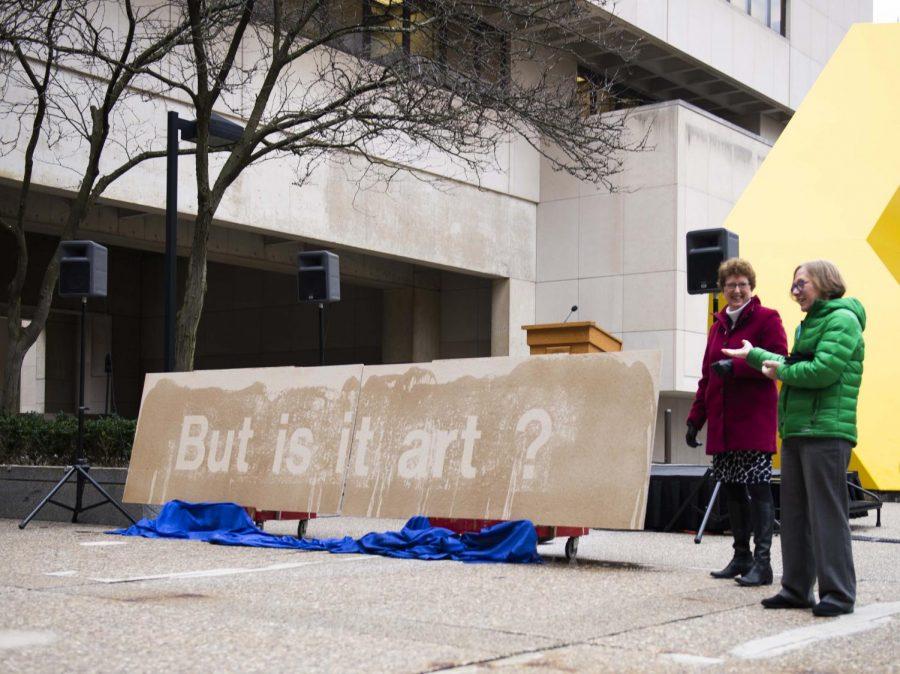Art here, there and everywhere: Pitt to catalog, purchase public art
Provost Ann Cudd and Assistant Provost Nancy Tannery stand next to a board that displayed the words “But is it art?” after having water poured on it.
January 30, 2020
Thousands of Oakland residents pass through “Light Up,” the large yellow sculpture in Posvar Hall Plaza, on their way to classes or meetings everyday, not thinking twice about it. But on Thursday, it was the center of attention.
Provost Ann Cudd and Greg Scott, the senior vice chancellor for business and operations, announced Thursday on a stage in front of the sculpture that the University would put more funding and energy into providing more public art around campus.
The new initiative is part of the 2019-20 academic year’s Year of Creativity, the sixth iteration of the “Year of” program, which “aims to encourage the creative spark in all of us.”
An Art on Campus committee has been formed to highlight existing art, while also adding new pieces. The panel is headed by Assistant Provost Nancy Tannery and Mary Beth McGrew, associate vice chancellor for planning, design and real estate. Other members of the committee include:
- Zach Brodt, a University archivist
- Jon Goldstein, vice chancellor for communications, donor relations, and volunteer management
- Canard Grigsby, a University architect
- Sylvia Rhor, director and curator of the University Art Gallery
- Kirk Savage, professor and chair of the Department of History of Art and Architecture
The initiative builds on a previous $49,000 grant awarded in fall 2019 by Chancellor Patrick Gallagher’s office to several University units, including the Department of History of Art and Architecture, University Library System, Frick Fine Arts Library and University Art Gallery, to survey and record all of Pitt’s public art pieces. The grant awardees also built a website to display public art at the University and provide information on each piece.
The committee has established a four-phase plan to integrate more art into the University. First, it will collect information on all of the current art pieces. Then, it will focus on improving Alumni and Mervis halls and artwork in outdoor public spaces, as well as recommending a collection management database system for Pitt to utilize. The committee will then write a report of recommendations for a comprehensive art inventory and management plan at Pitt.
Cudd said adding art in more public places will improve campus for visitors and students alike.
“It makes the campus a much more vibrant place to visit,” Cudd said. “It makes it special for visitors, but also for our faculty, staff and students.”
Scott added that art can communicate different things to different people, bringing multiple different perspectives together in one place.
“We may not agree on what is considered art, and that’s ok — beauty is certainly in the eye of the beholder,” Scott said. “Our reflections and conversations are what matter most, embracing the creativity, diversity and new perspectives that art offers each one of us.”
Cudd said the purpose of the initiative is to highlight current art on display around campus, as well as provide new pieces.
“We have a lot of great pieces already, such as the Tony Smith ‘Light Up’ piece that we are standing in front of,” Cudd said, “We want to be able to make sure that we celebrate and archive and bring attention to this art.”
Westinghouse Electric originally commissioned the “Light Up” sculpture in 1971 for its headquarters in Downtown, located at the Gateway Center. It was later donated to the University in 1989, after plans were made to renovate its original location.
Following Cudd and Scott’s remarks, Tannery and McGrew performed a creative water pouring. The duo spilled water onto a board, which caused invisible paint to transform into the words, “But is it art?” which was met with surprise and slight whispers from the crowd.
About two dozen faculty and students attended the announcement and provided feedback on survey cards about what art they would like to see around campus.
Sarah McCafferty, a junior marketing major, said she is pleased that the University is working on adding art to campus. She said the University has many talented artists, and would like to see an increase in student art displayed in University buildings, especially the William Pitt Union, where she works as a student house manager.
“I’m happy that they’re funding more art to campus,” McCafferty said. “I care a lot and I’m really glad that they’re putting more funding into art around campus to make it more vibrant.”
Gloria Givler, a first-year engineering major, said she spends a lot of time in Benedum Hall and would like to see more art in the building.
“I feel like the only art piece that I really see is [‘Light Up’]. I think it would definitely be interesting to have more art on campus,” Givler said. “It would be nice to have something to liven it up a bit.”
McCafferty said adding student artwork can have a big impact on the way people feel about belonging to the University.
“I feel like sometimes if a building doesn’t have student work in it, it feels more like an institution, rather than a community,” McCafferty said. “I think art is really good for building a community and making people feel more ingrained in a school.”



